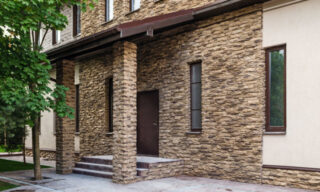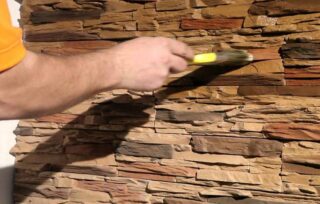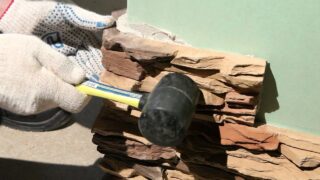Any building built of bricks, beams and foam concrete requires finishing in order to protect the load-bearing structures from environmental influences, as well as to give the structure a presentable and finished look. One of the most popular technologies in this area is facing a house with artificial stone. The procedure has its own characteristics, but it is not so complicated that a developer without experience could not do it with his own hands. The success of the event depends on the correct design of the building, the choice of material and adherence to the technology of its installation.
Varieties of decorative stone

The modern market is saturated with a wide variety of types of tile finishes, differing in composition, color, texture and installation methods.
Decorative stone for exterior home decoration is divided into the following categories:
- Natural. Differs in increased strength, massiveness, reliability and durability. Extraction is carried out in quarries, after which the lumps are cut into plates, from which plates of the desired configuration are cut. For the decoration of buildings outside, marble, granite, dolomite, basalt and limestone are used. Wealthy people can afford jade, aquamarine, apatite and turquoise.
- Artificial. It is made from sand, cement and acrylic polymers. The addition of pigments makes it possible to achieve a true imitation of any natural analogue and even surpass them in beauty and color saturation. In private and commercial construction, tiles, clinker tiles and porcelain stoneware are used.
The facing stone can be used independently and in combination with facade plaster. The material is applied to the walls and basement of the building.
Selection rules
When choosing a stone for cladding a house, a number of criteria should be taken into account that determine the operational and aesthetic characteristics of the material.
It is necessary to take into account the following characteristics:
- Price. For many developers, this indicator is decisive, but it should not go to the detriment of quality.
- Specific gravity. Natural stone is so heavy that it requires strengthening of the foundation.
- Wear resistance and durability. In a megalopolis and an area where strong winds prevail, the advantage should be given to natural materials.
- Strength. The outer cover must be able to withstand impacts from hard and sharp objects used by vandals without loss.
- Water absorption. It should be minimal, otherwise the surface will collapse during freezing and thawing.
When buying material, you need to pay attention to the absence of cracks, chips, color depth. Price matters too. A quality product cannot be cheap. There must be a manufacturer's certificate without fail.
Advantages and disadvantages

Any building material has its own strengths and weaknesses. Decorative finishing stone is no exception. Both categories are somewhat different in this aspect, so it is better to consider their characteristics separately.
Advantages of natural stone:
- strength;
- durability;
- wear resistance;
- naturalness;
- the depth of the pattern.
The material has fewer drawbacks. These include high price and heavy weight.
Artificial stone for exterior decoration of the house has the following advantages:
- affordable cost;
- small specific gravity;
- lack of water absorption;
- ease of installation;
- ease of processing with hand tools;
- a wide range of colors.
The disadvantage of the polymer coating is that it is prone to abrasion and still not as strong as natural counterparts.
There is no one-size-fits-all solution in the choice of finishes; it is also expedient in relation to the specific conditions in which the building is operated.
Required tools and materials

The cladding can be installed wet or dry. The first is used for finishing houses made of bricks and foam blocks, the second for buildings made of boards and beams.
To clad a building using mortar, you will need:
- notched and even trowel;
- scraper;
- mixer;
- nail puller;
- paint brush;
- putty;
- primer;
- tile adhesive;
- plastic crosses;
- grout for joints;
- rubber spatula;
- level.
The dry method involves the use of such tools and materials:
- drill;
- screwdriver;
- Bulgarian;
- scissors for metal;
- steel profiles;
- self-tapping screws;
- plastic dowels.
In both cases, you will need a stable ladder, an assembly helmet, safety glasses and gloves.
Home decoration technology with decorative stone

The initial stage of finishing is the preparation of the base.
It involves performing the following actions:
- removal of protruding fragments;
- patching up irregularities;
- cleaning the surface from mold, paint, oil stains;
- fixing all poorly adhered parts;
- treatment of walls with a deep penetration primer.
Wet assembly sequence:
- Installation of the lower starting profile.
- Mixing the solution.
- Applying glue to the wall, creating grooves on it.
- Starting from the corner, applying the boards to the base, using crosses to maintain the width of the joints.
- Fitting the fragments to the remaining openings.
- Grouting.
- Surface cleaning.
Each subsequent row must be laid with an offset of half a figure.
The sequence of installation of a ventilated facade using decorative stone:
- Installation of vertical and horizontal profiles.
- Screwing on the guides to accommodate the cladding.
- Fastening of thermal insulation boards. Basalt wool is considered the best option.
- Installation of vapor barrier and windproof film.
- Installation of stone tiles.
The decorative stone coating does not require special maintenance. It is necessary to periodically clean it from dust, wash and rub it with a special polish. If scratches appear on the surface, they can be sealed with polymer grout without problems. If the tile does break, it is easy to replace it, for which you need to have a small supply of material.








